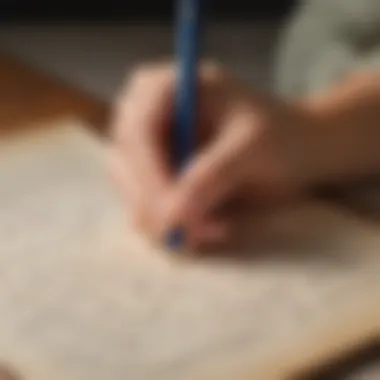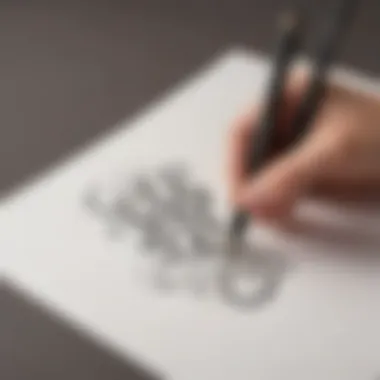Elevate Your Handwriting: A Comprehensive Guide to Enhancing Penmanship Skills


The landscape of handwriting improvement beckons us into a realm where precision meets creativity. From the foundational building blocks of good penmanship to the intricacies of refinement, this guide stands as a beacon for those seeking to elevate their written expression. As we embark on this journey, it is essential to grasp the importance of clear and legible writing in conveying one's thoughts effectively.
In the realm of pen-to-paper mastery, understanding the fundamental principles of letter formation and spacing is paramount. By delving into the mechanics of forming each letter with deliberate strokes and maintaining appropriate spacing between words, individuals can lay a solid groundwork for enhancing their handwriting proficiency. Furthermore, attention to detail in creating consistent letter sizes and maintaining a smooth flow of writing contributes significantly to the overall aesthetic appeal of one's script.
Common Mistakes in Handwriting
Letter Formation Inconsistencies
One prevalent pitfall in handwriting improvement stems from inconsistencies in letter formation. By addressing this issue through focused practice and mindful attention to detail, individuals can mitigate the impact of irregular letter shapes on the overall clarity of their writing. Emphasizing proper letter construction through guided exercises can pave the way for smoother and more uniform script.
Illegible Writing Due to Poor Pen Grip
Another stumbling block on the path to refined penmanship is the presence of a poor pen grip, leading to illegible writing. Rectifying this hurdle involves adopting a comfortable and ergonomic grip that facilitates fluid movement across the page. Through targeted exercises and gradual adjustment, individuals can cultivate a suitable pen grip that aligns with the natural contours of their hand.
Alignment and Spacing Challenges
Navigating the intricacies of alignment and spacing presents a formidable challenge in the pursuit of improved handwriting. Addressing alignment discrepancies and spacing irregularities requires close attention to detail and a conscious effort to maintain uniformity throughout the written text. By implementing strategies such as utilizing guidelines and grid paper, individuals can enhance their spatial awareness and ensure coherent placement of letters and words.
Advanced Techniques for Handwriting Refinement
Flourishes and Embellishments
Embarking on the journey of advanced handwriting refinement introduces individuals to the art of flourishes and embellishments. These decorative elements not only add a touch of elegance to written compositions but also showcase the writer's artistic flair. By experimenting with different styles and flourishes, individuals can imbue their writing with personality and character, elevating it to a new level of sophistication.
Calligraphy and Decorative Scripts
Venturing into the realm of calligraphy and decorative scripts unveils a realm of artistic expression through written form. By exploring various calligraphic styles and mastering the nuances of ornate scripts, individuals can transform their writing into intricate works of art. Through diligent practice and a keen eye for detail, attaining proficiency in calligraphy opens doors to a world of boundless creativity.
Synthesizing the Journey
As we traverse the diverse landscapes of handwriting improvement, from mastering the basics to delving into advanced techniques, a holistic approach emerges. Each stroke of the pen, each curve of a letter, bears the imprint of dedication and intention towards honing one's craft. By synthesizing the information and techniques presented throughout this guide, individuals can chart a course towards penmanship excellence, where clarity and creativity converge in harmonious balance.
Introduction
In the realm of written communication, the significance of handwriting transcends mere penmanship; it serves as a gateway to artistry and intellect. The art of handwriting holds a distinctive position in the world of education and personal development, embodying a fusion of cognitive functions and creativity. Within the confines of this guide, we unravel the threads that bind a scribble to self-expression, delving into the intricate dance between hand and mind.
Handwriting, often overlooked in the digital era, wields a potent influence on intellectual development and individuality. It's not merely about ink on paper but a nuanced form of expression that mirrors one's personality and attention to detail. Encouraging a child to embrace the art of handwriting is akin to igniting a spark of creativity that can illuminate their path to success. By nurturing this skill, parents and educators pave the way for improved communication and cognitive growth.
In this technologically driven age, where keyboards reign supreme, the revival of handwriting stands as a testament to its enduring importance. The tactile act of shaping letters by hand cultivates fine motor skills, enhances memory retention, and fosters a deeper connection between the writer and the written word. Therefore, delving into the nuances of handwriting is not just a journey of ink and paper but a voyage into the intricacies of human cognition and self-expression.


Understanding Handwriting
In the realm of improving handwriting, understanding the intricacies of this essential skill becomes paramount. Handwriting serves as a gateway to effective communication and cognitive development. As we delve deeper into the fundamentals of good handwriting, we unearth a treasure trove of elements that contribute to its mastery.
Importance of Handwriting
Enhances Communication
One of the primary facets of handwriting lies in its ability to enhance communication. The act of transcribing thoughts onto paper fosters clarity and precision in conveying ideas. By honing one's handwriting skills, individuals can imbue their written words with eloquence and coherence, thereby strengthening the impact of their message. Through the tactile experience of penning down words, communicators can establish a deeper connection with the content, facilitating better comprehension for the reader.
Aids Cognitive Development
Handwriting plays a crucial role in cognitive development, especially in the formative years of a child. The tactile engagement of using pen and paper stimulates various regions of the brain associated with language processing and fine motor skills. By practicing handwriting regularly, individuals can enhance memory retention, promote creativity, and refine their motor coordination. Moreover, the act of physically shaping letters encourages neural pathways involved in language acquisition, contributing to overall cognitive agility and linguistic proficiency.
Elements of Good Handwriting
Legibility
The cornerstone of good handwriting lies in its legibility. A well-formed script enables easy comprehension of written content, allowing the reader to decipher the intended message without struggle. Legible handwriting exhibits clear letter formations, consistent sizing, and adequate spacing between words, ensuring effortless readability. By prioritizing legibility, writers can effectively convey their thoughts with precision and coherence, fostering enhanced communication and comprehension.
Consistency
Consistency in handwriting pertains to the uniformity of letter formations and spacing throughout a written piece. Maintaining consistent slant, size, and spacing lends aesthetic appeal to the script and improves overall readability. Consistency enables readers to follow the flow of the text seamlessly, enhancing the visual appeal of the written work. By cultivating consistency in handwriting, individuals can elevate the standard of their script, creating a polished and professional impression.
Spacing
Proper spacing between letters, words, and lines is vital for ensuring readability and aesthetics in handwriting. Adequate spacing facilitates smooth transitions between words, preventing overcrowding or clustering of text. Well-managed spacing enhances the overall presentation of the script, allowing for a harmonious balance between letters and words. By paying attention to spacing, writers can optimize the clarity and visual impact of their handwriting, elevating it to a more refined and structured form.
Alignment
Alignment denotes the arrangement of text along a straight, consistent baseline, enhancing the organization and visual appeal of handwriting. Proper alignment ensures that letters are positioned evenly across the page, creating a neat and ordered composition. Whether justifying text to the left or centering it for aesthetic purposes, alignment plays a crucial role in defining the structure and readability of written content. By mastering alignment, writers can present their work in a professional and visually appealing manner, capturing the eye of the reader with precision and symmetry.
Basic Techniques for Improvement
Handwriting is an art that requires precision and dedication. In this article, we delve into the crucial aspects of basic techniques for improvement, which serve as the foundation for enhancing one's handwriting proficiency. The basic techniques act as building blocks, setting the stage for further development and mastery. Understanding the importance of proper grip, posture, letter formation, and consistent practice is paramount in honing one's handwriting skills to perfection.
Proper Grip and Posture
One of the integral components of improving handwriting is adopting the correct grip and posture while writing. The way in which a pen or pencil is held can significantly impact the legibility and fluidity of one's writing. Ensuring a proper grip promotes comfort and control, allowing for smoother penmanship. Furthermore, maintaining an appropriate posture while writing not only enhances physical comfort but also contributes to better hand-eye coordination, resulting in more refined letter formation.


Letter Formation
The formation of letters plays a vital role in the overall aesthetics and comprehensibility of handwriting. Each letter should be crafted with care, paying attention to consistency in size, shape, and slant. Adopting a consistent approach to letter formation instills a sense of rhythm and flow in writing, making the text more visually appealing and easier to read.
Practice Strategies
Practice is key to improving handwriting skills, and employing effective strategies can expedite this process. Incorporating regular writing exercises into one's routine helps in reinforcing muscle memory and honing fine motor skills essential for neat handwriting. Copying texts from diverse sources exposes individuals to different styles and structures, broadening their handwriting repertoire. Tracing exercises serve as a useful tool for practicing letter formation and developing a steady hand.
Regular Writing Exercises
Regular writing exercises involve repetitive writing tasks aimed at enhancing muscle memory and improving hand dexterity. These exercises are fundamental in reinforcing proper grip and posture, ultimately leading to improved handwriting proficiency. The consistency and frequency of regular writing exercises are imperative in ingraining good writing habits and overcoming common challenges.
Copying Texts
Copying texts is a technique that allows individuals to emulate varied writing styles and patterns. By replicating existing text, writers can experiment with different alphabets, letter sizes, and spacing, expanding their repertoire and improving their overall handwriting versatility. While copying texts may seem meticulous, it fosters attention to detail and precision in writing, laying a strong foundation for further refinement.
Tracing Exercises
Tracing exercises involve overlaying a transparent sheet with pre-written text over which individuals trace the letters. This method aids in understanding letter morphology, stroke sequence, and spatial awareness. Tracing exercises facilitate muscle memory development and assist in refining letter formation. Additionally, they provide a visual guide for beginners, helping them grasp the intricacies of each letter's structure and proportions.
Intermediate Techniques for Enhancement
The section focusing on Intermediate Techniques for Enhancement elucidates the pivotal advancement aspect in refining one's handwriting expertise. Delving into the realm of intricate methodologies and approaches, this segment imparts a nuanced understanding of the subject matter. By honing in on specific elements paramount to handwriting ascension, individuals can elevate their competency significantly. The importance lies in bridging the gap between foundational skills and mastery, thus catalyzing personal growth and proficiency. Embracing Intermediate Techniques for Enhancement empowers individuals to transcend mediocrity and strive for excellence, instilling a sense of diligence and precision in their writing endeavors.
Consistency and Rhythm
The facet of Consistency and Rhythm underscores the essence of uniformity and flow within handwriting execution. Maintaining Consistency and Rhythm is instrumental in enhancing readability and aesthetic appeal in written compositions. By cultivating a harmonious blend of uniformity in letter formation and fluidity in stroke execution, individuals can imbue their script with elegance and coherence. This section delves into the intricacies of fostering Consistency and Rhythm, shedding light on strategies to cultivate these attributes effectively. Elevating one's handwriting through Consistency and Rhythm not only augments legibility but also imbues the writings with a sense of rhythmical cadence, captivating readers and conveying thoughts with finesse.
Personal Style Development
Personal Style Development serves as a gateway to individuality and creativity in handwriting expression. Encouraging individuals to infuse their unique persona and flair into their script, this segment celebrates diversity and personalization. By embarking on a journey of self-discovery through handwriting, individuals can unlock the untapped reservoirs of creativity and originality within themselves. Nurturing Personal Style Development sparks innovation and self-expression, allowing writers to carve a distinct niche in the realm of penmanship. This section delves deep into the nuances of personalization, guiding individuals on how to harness their individuality to craft a signature style that resonates with their persona.
Line and Margin Control
Line and Margin Control encapsulate the fundamental aspects of spatial awareness and presentation aesthetics in handwriting. Mastering Line and Margin Control involves meticulous attention to detail and precision in spatial arrangement on a writing surface. By understanding the significance of consistent line spacing and balanced margins, individuals can enhance the legibility and visual appeal of their script. This section explores the art of precise alignment and margin setting, imparting strategies to fine-tune linearity and spatial distribution. Proficiency in Line and Margin Control not only elevates the overall aesthetics of handwriting but also fosters a disciplined approach to presentation, reflecting a keen eye for detail and polished refinement.
Advanced Tips for Mastery
In the realm of handwriting improvement, advanced tips play a pivotal role in transforming one's handwriting from adequate to exceptional. These tips serve as the culmination of foundational principles and intermediate techniques, propelling individuals towards mastery in their penmanship. By delving into the intricacies of pen control, speed optimization, and style refinement, advanced tips offer a pathway to elevate handwriting skills to an art form. Through disciplined practice and a keen eye for detail, individuals can hone their craft and achieve unparalleled precision and elegance in their written expression.


Speed and Fluidity
Among the advanced avenues for enhancing handwriting, speed and fluidity stand out as essential components. Speed is not merely about writing fast but rather finding a harmonious balance between swiftness and clarity. Fluidity, on the other hand, pertains to the smoothness and gracefulness of each stroke, creating a seamless flow across the page. By focusing on increasing writing speed without sacrificing legibility and integrating fluid movements into each letter, individuals can imbue their handwriting with a sense of dynamism and sophistication.
Incorporating Calligraphy Techniques
In the realm of handwriting refinement, incorporating calligraphy techniques introduces a touch of elegance and artistry to one's writing style. Calligraphy, known for its ornate scripts and decorative flourishes, offers a unique approach to shaping letters and words. By exploring calligraphic elements such as varying stroke thickness, flourishing, and embellishments, individuals can add a distinctive flair to their handwriting. The fusion of calligraphy techniques with everyday writing not only enhances visual appeal but also cultivates a deeper appreciation for the art of penmanship.
Consistent Practice Regimen
A consistent practice regimen serves as the bedrock for mastering advanced handwriting techniques. Regular and deliberate practice is essential for ingraining newly acquired skills and maintaining proficiency over time. By establishing a structured practice routine that focuses on targeted areas of improvement, individuals can accelerate their progress and overcome hurdles in their handwriting journey. Consistency breeds discipline and refinement, allowing individuals to push the boundaries of their handwriting proficiency and achieve unparalleled levels of mastery.
Common Mistakes to Avoid
Handwriting improvement is a meticulous endeavor that requires a keen eye for detail. When delving into the realm of handwriting refinement, it is crucial to be aware of common pitfalls that can hinder progress. By identifying and understanding these mistakes, individuals can proactively work towards rectifying them. This section aims to shed light on the key areas to watch out for to ensure a smooth journey towards enhancing one's handwriting. The ability to recognize and correct common mistakes plays a vital role in the handwriting improvement process, ensuring steady advancement and skill development.
Excessive Pressure
One prevalent issue in handwriting is the application of excessive pressure while writing. When individuals press too hard with their writing instrument, it can lead to a variety of problems such as ink smudging, paper tearing, and discomfort in the hand. Excessive pressure not only affects the overall quality of the handwriting but also hampers the writer's speed and fluidity. By learning to control the amount of pressure applied during writing, individuals can achieve a more consistent and legible output. This section delves into the impact of excessive pressure on handwriting and provides practical tips on how to regulate pressure effectively to improve writing comfort and quality.
Inconsistent Sizing
Another common mistake that plagues handwriting is inconsistent sizing of letters and words. Inconsistencies in letter sizes can disrupt the flow and readability of the text, making it challenging for readers to comprehend the content. Understanding the importance of maintaining uniform sizing throughout the writing process is essential for conveying information clearly and effectively. This subsection delves into the nuances of sizing discrepancies in handwriting and offers guidance on how to achieve uniformity in letter sizes, ensuring a cohesive and polished written output.
Improper Paper Positioning
Proper paper positioning plays a significant role in handwriting proficiency. Incorrect positioning of the paper can cause discomfort, strain, and irregularities in writing. Improper angles or orientations may result in distorted letter formations and inconsistent spacing. By addressing paper positioning errors, individuals can optimize their writing posture, leading to improved hand stability and control. This section explores the impact of paper positioning on handwriting quality and provides practical insights on how to adjust paper placement for enhanced writing comfort and precision.
Utilizing Technology for Improvement
Utilizing Technology for Improvement is a pivotal aspect of the comprehensive guide to Enhancing Handwriting Skills. In today's digital age, incorporating technological tools can significantly enhance the learning and practice experience for individuals looking to refine their handwriting. By integrating technology, individuals can access a wide array of resources and aids that cater to different learning styles and preferences. These tools offer interactive features that engage users and provide valuable feedback on areas that need improvement.
One key benefit of Utilizing Technology for Improvement is the provision of Handwriting Analysis Tools. These sophisticated tools allow users to analyze their handwriting patterns, identifying areas of weakness and offering targeted exercises to address them. By leveraging data-driven insights, individuals can track their progress over time and make informed adjustments to their practice regimen. Handwriting Analysis Tools not only enhance self-awareness but also streamline the improvement process, making it more efficient and effective.
Moreover, Digital Writing Platforms play a crucial role in modern handwriting enhancement. These platforms offer virtual spaces where individuals can practice writing in various styles and fonts, providing a dynamic learning environment. Digital Writing Platforms come equipped with features such as customizable writing exercises, real-time feedback, and interactive tutorials, making the learning process engaging and personalized. Additionally, these platforms enable users to store their work electronically, allowing for easy access and organization of practice materials.
Conclusion
In the realm of improving handwriting, arriving at a thoughtful conclusion is paramount to discerning the significance and lasting impact of cultivating this skill. Handwriting serves as a fundamental element of communication, transcending the mere act of scribbling words on paper. The culmination of this comprehensive guide delves into the multifaceted benefits that mastering handwriting entails and opens avenues for self-expression and cognitive refinement.
As individuals progress through the various sections of this guide, they embark on a journey that not only hones their handwriting but also nurtures cognitive abilities linked to motor skills and language proficiency. The nuanced aspects explored in earlier sections – from proper grip and posture to advanced calligraphy techniques – converge in the conclusion to emphasize the holistic development that stems from dedicating time to enhancing handwriting proficiency.
Moreover, the reinforced understanding of consistency, rhythm, and personal style presented in the intermediate stage translates into a nuanced appreciation for the artistry of handwriting. By examining common mistakes to steer clear of, learners gain invaluable insights that sharpen their attention to detail and precision. Significantly, adopting a consistent practice regimen forms the bedrock upon which mastery of handwriting is built, highlighting the importance of perseverance and diligence in skill refinement.
Technological integration is also underscored in this conclusion, showcasing the harmonious blend of tradition and innovation for modern learners. Embracing digital writing platforms and leveraging handwriting analysis tools punctuates the evolution of handwriting practice, amalgamating traditional methods with contemporary advancements.
In essence, this conclusion encapsulates the essence of the entire guide by portraying handwriting as both an art form and a cognitive exercise. It underscores the intricate balance of creativity, discipline, and technological fluency required to navigate the landscape of evolving writing practices. As readers internalize the insights provided in this guide, they are equipped to not only improve their penmanship but to embark on a transformative journey towards self-improvement and cognitive finesse.







